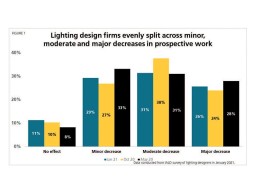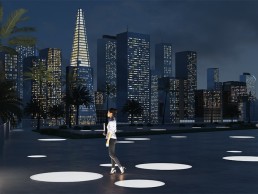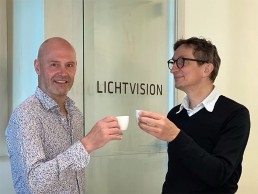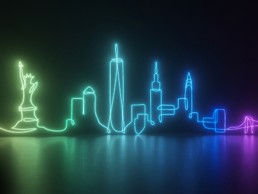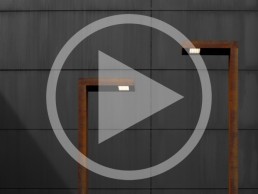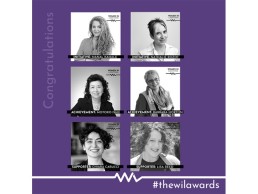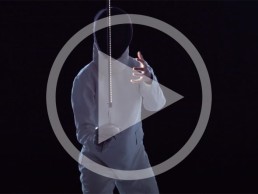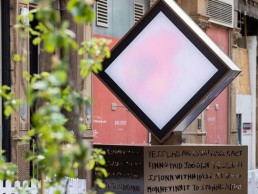One Year On: Impacts of Covid-19 on the lighting design industry
Throughout the Covid-19 crisis, the IALD has carried out regular surveys of the lighting design profession to see how it continues to be affected by the global pandemic. Here, they present their most recent findings.
As the Covid-19 crisis extends into 2021, lighting design firms continue to experience ongoing challenges as the economy continues to react to the global reach of the pandemic. While vaccines are being distributed and administered, rollouts globally have been slower than many had hoped. Lighting design firms and lighting designers have experienced a variety of effects from this pandemic based upon size, geographic location, and distribution of work across different sectors.
To better understand these challenges and gain insight into the pandemic’s ongoing impact, the IALD surveyed lighting design business owners and principals about the Covid-19 crisis in May 2020 and October 2020. This survey was repeated at the beginning of 2021, opening on 14 January and closing on 29 January, and posed questions for the January to March 2021 time frame. A total of 342 lighting designers, representing 46 countries, responded to the most recent survey. Lighting design firm sizes ranged from solo practitioners (22%); two to five employees (27%), six to ten employees (18%), 11 to 49 employees (25%); and 50+ employees (8%).
Lighting Design Firms Still Resilient
In May 2020, when the IALD first surveyed lighting designers, the results indicated that most lighting design firms were not fully prepared for this crisis – not unlike many other businesses worldwide. Though the majority of the respondents from this time did not have a business continuity plan in place when the Covid-19 pandemic started, almost 30% of respondents did. While many of us were hoping for 2021 to start off strong, the ongoing pandemic damped any strong recoveries. In 2021, survey results indicate that less than 10% of firms reported no negative effect from the pandemic, and most firms are largely maintaining the status quo since the October 2020 survey.

The full impact of the global pandemic remains unknown. In May last year, most firm owners (54%) anticipated it would take between one to three or more years before businesses return to pre-Covid-19 levels. In October, many lighting designers shifted the narrative from when business returns to normal to how the lighting design profession will look in the future. And in January 2021, many lighting designers recognised that the built environment will shift and there will be changes in how business is conducted.
Lighting Design Firms Maintain Status Quo
Lighting design firms around the world continue to experience a range of effects on prospective work. While only a small portion of owners and principals (8%) have not experienced any negative effect on prospective work, most firms seem split among a minor decrease (29%), a moderate decrease (31%) and a major decrease (26%) in prospective projects.
Solo practitioners seem to have been hit the hardest and were among the largest segment of those who cited a major decrease (26%) in prospective work. Firms with two to five employees were even split among minor, moderate, and major decreases. We start to see less negative impact – more moderate and minor impact – on prospective work as the firms (11 to 49 and 50+) increase in size.
Lighting design firm owners’ and principals’ confidence in getting new proposals and signed contracts in the months of January to March 2021 is much higher (approximately 20%) from the first survey in May 2020. While we still see an increase from October 2020 to January 2021, this minor increase equates 8% greater chance of getting new proposals and only 2% increase for signed contracts for January to March 2021. This means that optimism has increased slightly since the end of 2020.
Despite the minor anticipated increase in new proposals, lighting design firms predict an increase in revenue losses, up 6% from 32% in October 2020 to 38% in January 2021. This indicates a slight downturn in revenue for the beginning months of this year.
No Change In Breadth of Sectors Affected
Many sectors in which the lighting design community works have been affected by Covid-19, with some experiencing growth and others showing a decrease in activity. The sectors that are showing the most promise have not changed since the last survey. Increases are in the following sectors: residential (41%), public/government (20%), and health (19%).

As with the last survey, the same sectors that have been hit hard are more public facing like hotel (59%), retail (58%) and amusement and recreation (55%). With a portion of the workforce still working from home, the office sector has also seen a strong decrease (48%).
However, most current projects (73%) are either moving ahead as normal, or at a slightly slower pace. The January 2021 survey shows little change since the October 2020 survey. January 2021 shows a slight increase in slowed or stopped projects compared to October 2020.
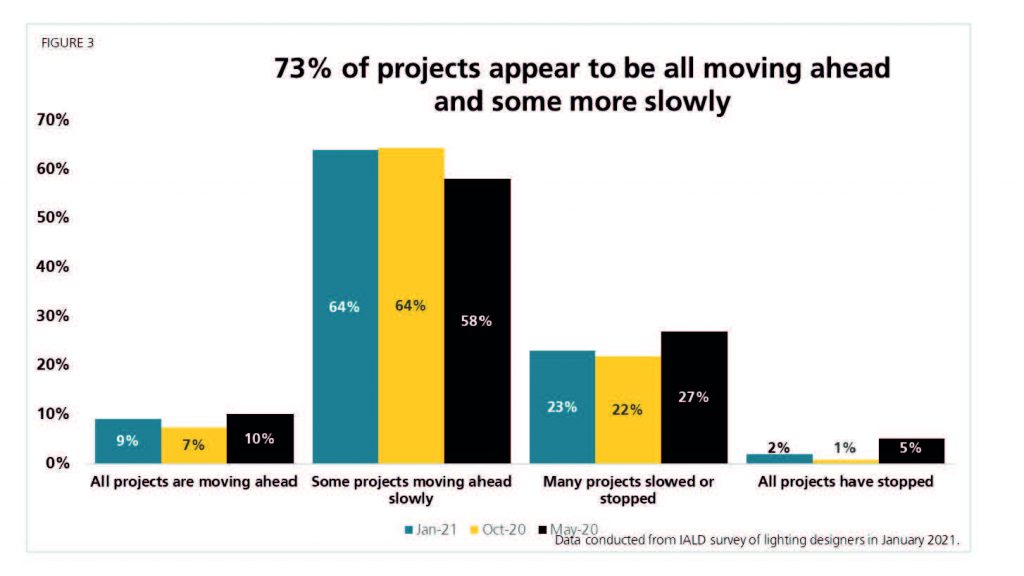
Top Covid-19 Related Issues the Same
Since May 2020, the top three issues have remained the same for lighting design firms, but their severity has decreased indicating that things are looking more optimistic. These three issues are: increases in project delays/projects on hold; stalled or stopped construction on projects; and difficulties in getting lighting equipment. Owners or principals are seeing fewer issues with stalled projects and collecting payments since May 2020. There have also been increases in projects getting financed and abnormally high prices due to market uncertainty. However, neither of those issues are in the top three issues reported.
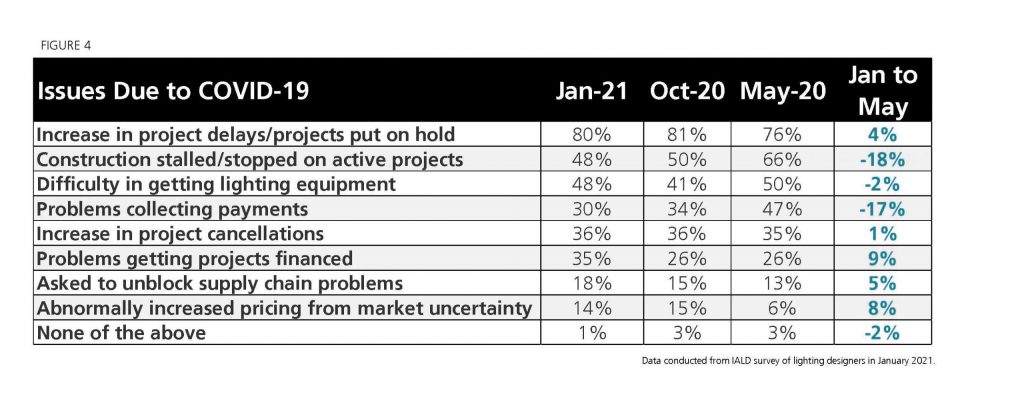
When Covid-19 first hit, most firms (71%) put a freeze on major expenditures. Freezes on major expenditures dropped from 71% in May 2020 to 46% in January 2021. 60% of firms in May placed a hold on discretionary spending compared to 48% in January 2021. Hiring has also softened indicating that 62% of firms are open to new hires.
The Positives for Lighting Designers
While many lighting designers have a range of thoughts from positive to negative about the impacts of the pandemic on the lighting design profession, we also know that many lighting designers have seen positives outcomes as well.
Overwhelmingly, lighting designers and teams cited that they can effectively work remotely and be productive. There were threads from lighting designers about how remote work allows for greater freedom and flexibility. One respondent shared that as remote work became more acceptable, there was more empathy for designers who had to juggle work and family responsibilities and demands. Another respondent shared that working remotely has changed the perception about being open to different working hours to accommodate personal schedules. One lighting designer happily shared: “I can maintain the calibre of work by working from home and I am still keeping my clients happy. I love the flexibility of working from home.”
A second theme that emerged from working remotely is that many lighting designers agreed that remote work cut down on unnecessary travel and expenses. This was especially true for lighting designers who travel internationally for client meetings and projects. One designer was relieved and shared that working from home was very efficient and saved a lot of travel time: “With more international projects this is a huge relief.”
Lighting designers have had more time to reflect on how the pandemic has affected them and their colleagues. One designer shared that the pandemic showed them that their company really cares about their employees. The staff had become closer on a personal level, and this has increased the strength of the team. A business owner shared that the pandemic gave them the opportunity to learn more about their employees and themselves. They already knew that they were able to operate remotely, and what they didn’t know they figured out. One designer said they learned about humility – how important “the in-between” is on all levels, adding that many high-end architects have “let their guard down” and become more “human.”
The pandemic also opened new business possibilities. Less travel allowed for some firms to focus more time and energy on strategic thinking and planning. From diversifying markets, studying new areas, to exploring new business, the pandemic may have given firm owners the chance to reinvent and expand. While the pandemic has affected lighting designers differently, there is hope that the lighting design profession will emerge stronger. As one designer said: “Our value as a design team member is evident as our workload has not diminished. The value of lighting is clearly an important asset to those still able to move forward with projects.”
David Morgan Review: LAM32 minimumMAXIMUM
After it took home the KIT - Exterior trophy at the 2020 [d]arc awards, David Morgan was keen to take a closer look at LAM32’s minimumMAXIMUM range of in-ground illuminated panels.
When a recently formed Italian architectural lighting company produces a series of floating illuminated jellyfish for an iconic hotel project in Croatia, the combination of creativity and technical potential is clearly evident.
The unusual name of this company, LAM32, derives from Luce A Misura”, (tailormade light) while the number 32 was the sum of the years of experience of the two founders.
With a background interest in electronics, and after working in marketing for iGuzzini, then for Targetti as a sales agent, Matteo Appignanesi launched LAM32 with a partner in 2007. Their aim was to create luminaires and lighting systems capable of satisfying the needs of lighting designers around the world.
Initial sales came from the design and production of custom luminaires for a variety of international projects including the remarkable Hotel Belleveue concept with Dean Skira in Croatia. This is the project that involved the development of gigantic floating illuminated jellyfish with trailing side-lit fibre optic tendrils; the product and development images are presented in detail on the LAM32 web site.
In 2011 the company introduced the first standard ranges, designed in-house, including exterior-rated Round Evo and Wave projectors, which remain in the range today. The company currently employs 36 people and is located near the Adriatic coast of Italy with sales activity in all major international markets.
The latest product range introduced by LAM32 is the extensive minimumMAXIMUM in-ground illuminated panel range that recently won the best exterior lighting product accolade at the 2020 [d]arc awards.
This remarkable range includes five different panel shapes and each one is available in five sizes, hence the overall product range name. The first products to be commercialised were the Circles followed by the Square, Rectangular, Line, and Triangular shapes. The luminaires are drive over-rated, being strong enough to withstand 5,000kg loading. Both IP67 and IP68 options are available with the IP68 version being rated for continuous immersion in up to one metre of water.
Apparently, the initial concept for minimumMAXIMUM came from Matteo Appignanesi who then asked lighting designers Francesco Iannone and Serena Tellini from the pioneering Consuline consultancy to develop the full geometric collection. They proposed adding the logarithmic shaped triangles to complete the range and also suggested the ratio for the rectangular types, which are now based on the golden section. The stylish and informative brochure for the range goes into considerable detail about Western and Eastern systems of geometries and how these have affected architecture and design over the centuries.
The construction of the luminaires is very robust as would be expected with a drive over-strength, in-ground panel. The frosted finish, 15mm thick glass is bonded to a stainless-steel body with a 7mm layer of silicone. I was not able to open the luminaire to examine the light engine or diffusion system, but the lit effect is very even in the centre of the luminaire with a 20mm shadow running around the edges where the glass is bonded to the stainless body.
The overall depth of the luminaire body is only 36mm so the diffusion process is clearly effective to give such a uniform lit effect. The heavily engineered stainless steel in-ground housing increases the overall depth to 96mm, which fits into the many projects where a maximum 100mm recess depth is allowed in the slab build up depth to accommodate basement car parking areas. Anti-slip details can be added to the glass, appearing as visible dots on the surface.
The lumen output and efficiency are respectable for a diffuse luminaire of this type, the smallest circular size at 250mm diameter with 3000K LEDs provides up to 1,250lms with a consumption of 15W. The largest round luminaire is the 1,200mm diameter and provides up to 6,350lmswith a consumption of 76W. Standard LED colour temperatures are 2700K, 3000K and 4000K. Colour tuneable and RGB light engines are also available as custom options.
LAM32 undertakes all design and engineering in-house along with assembly and testing. Components are sourced locally from qualified ISO 9001 approved suppliers. It is understood that 90% of the materials used in the minimumMAXIMUM products can be recycled and the light engines can be factory replaced at the end of life, after around 75,000 hours of use.
The introduction of the range was delayed by around 10 months due to the pandemic, but samples have been distributed around the world and it is claimed that lighting designers have responded positively to the project possibilities that the range allows. The first project where the Circle type has been installed was at the Dalma Mall project in Abu Dhabi.
Lighting Design for the 21st Century: Applied research in lighting practice
Asst. Prof. Dr. Karolina M. Zielinska-Dabkowska IALD, IES, CIE, MSLL, RIBA, discusses three key and pivotal research topics for the future of our profession. She also presents some project examples where research has been performed to help derive outstanding results.
Basic research versus applied research
For those who are unfamiliar with research, it’s important to know there are two categories: fundamental (or basic) research [1] and applied research [2]. Basic research often discusses scientific ideas/theories, whereas applied research explores testing these ideas in practice to develop technology or techniques. It’s applied research that most interests lighting practitioners.
In the recent past, significant discrepancies in the spectral power distribution (SPD), correlated colour temperature (CCT) and colour rendering index (CRI) could be observed between the characteristics listed in lighting catalogues compared to obtained physical working lighting samples. The only explanation for this situation was the fact that previously, research was mainly performed in lighting labs owned by the lighting industry/specific lamp and luminaire manufacturers. (This usually involved expensive research equipment that the researchers from these labs understood how to operate). Furthermore, professional lighting designers most often did not have the necessary time, skills and access to the equipment required to verify these results. Therefore, some of the data could be manipulated.
Today though, due to the development of measuring equipment and improved accessibility (for example, small, calibrated handheld spectroradiometers with a flicker option), we as lighting designers can at least verify results by performing alternative measurements in our own practice. Access to free scientific knowledge is also now widely available. Additionally, improvements in research are being made via lighting designers and engineers who teach at the university level, and many students have the advantage of receiving excellent supervision when they perform research on light and lighting during their Master’s thesis and PhD studies.
Great lighting design that creates a pleasant and beneficial user experience in any given space doesn’t just occur miraculously. Rather, it’s built on the designer’s insights and understanding which comes from sound research and years of practice. This awareness comes from knowing the end users, as well as comprehending what’s best for them. It’s helpful to acknowledge that many of us perform research in our day-to day practice as part of the design process. However, there’s a tendency to disregard this, even though what we as lighting designers actually do, is applied research in practice.
In my view, there are three key research topics for the future of our lighting design profession that we should become familiar with. They are all based on the mounting research about daylight and artificial light and its impact on circadian relevance and biological stimulus. These are: environmental impact and light pollution, biophilic office design and user oriented daylight integrated lighting (DIL).These topics have been demonstrated below by some pioneering project examples, where research has been performed to help derive outstanding results.
Environmental impact and light pollution
Firstly, there’s the environmental impact of artificial lighting on humans, flora, and fauna, which includes light pollution. When lighting professionals began to illuminate skyscraper buildings in metropolitan cities in the 1920s and 30s, to make architecture and urban environment visually more prominent at night, it wasn’t even considered that these actions could have adverse consequences for living organisms in the future to come. Light was perceived as a positive medium that can beautify cities and be used as a powerful marketing and advertisement tool [3]. Over time, things have changed for the lighting design profession, as there’s an increasing body of knowledge from various research fields such as astronomy [4], biology [5], medicine [6], and ecology [7], all of which confirm that our design actions, if not carefully thought through and skilfully applied, could have far-reaching negative effects.
Due to accessibility of various information on the topic of environmental impact and light pollution from nighttime illumination via the internet, the general public were made aware of the situation and later, began taking things into their own hands, demanding better quality, improved, environmentally sensitive lighting [8]. This means that today, we must ensure that the illumination of urban elements such as buildings, squares, landmarks, and parks etc, is visually pleasing, as well as energy efficient, sustainable and responsible. There’s no doubt that lighting designers have a moral obligation to decline urban lighting commissions that do not support human health and environmental wellbeing [9].
While our cities were “painted with light” in the past, we simply didn’t have the knowledge that now exists. So, the illumination of our cities today must be executed with far more care, caution and restraint, and furthermore, our actions should bring about positive change. We should always consider the possible impact of lighting projects and be able to provide our clients with evidence-based answers to meet their demands.
The controversial illumination of Duijangyan’s irrigation system in Duijangyan, China, with jade-coloured lighting in the Minjing riverbed (Figure 1) is a reminder of the careless application of colourful external illumination that lacked any background research on the topic. Although some recognised lighting design practices have designed projects in the past like this example, which at the time, didn’t even consider the impact of lighting on the environment and fauna - this approach ended up facilitating important change because it was strongly criticised by biologists and fellow lighting designers. Case in point, lighting design practices today talk about dark infrastructures in urban environments being a much-needed positive transformation.
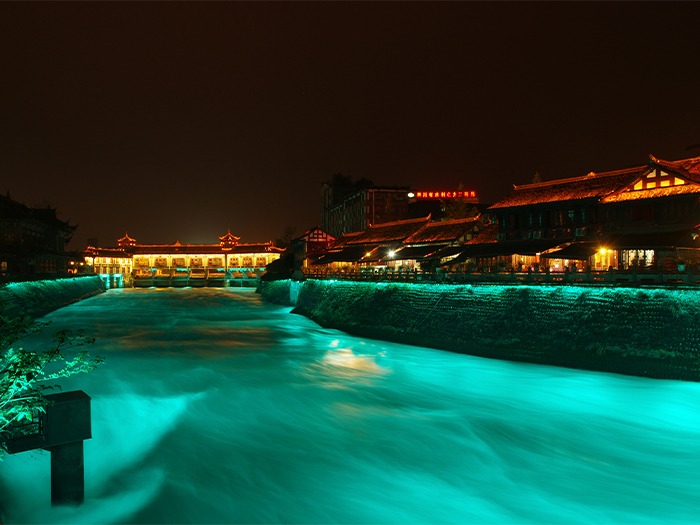
Example of a lighting proposal with negative environmental impact, as it not only creates light pollution, it also has an adverse impact on fish and other living organisms in the water. (Pic: © Peter Molnar)
Not many of us know that the 9/11 Memorial and its park to honour those who died on September 11, 2001, might have been illuminated as brightly as a baseball pitch. This was one of the requirements of the NYC police to create safe and secure spaces. (It’s a common misconception that more light horizontally equates to increased security, when this isn’t the case at all.) Thankfully, it was the courage of Paul Marantz, the founder of Fisher Marantz Stone (FMS), who disagreed with this requirement (Figure 2), as based on his years of observation and experience, he understood how people perceive three-dimensional spaces at night.
His solution was the proposal of a benchmarking tool. (Benchmarking in lighting design is a tool that has been employed for many years to search for ‘best practices’). This project required a few of my colleagues from FMS and I, to travel around Manhattan, where we measured the horizontal illuminance in public parks and squares to prove that with even low levels of horizontal illuminance, if the vertical surfaces of the buildings at the perimeter level in the distance, such as shop fronts or restaurants etc. are illuminated, then pedestrians will feel safe (Figure 3). This is a great example of applied research being carried out by lighting designers in 2004, before it became more widely applied in practice.
This project received a 2012 IALD Award of Excellence, a 2012 IESNA Lumen Awards of Excellence, and a 2012 IES Illumination Award of Merit.

9/11 Memorial, New York/USA demonstrating that if the vertical surfaces of the buildings at the perimeter level in the distance, such as shop fronts or restaurants etc. are illuminated, pedestrians will feel safe (Pic: ©360images/Jerome Boccon-Gibod).
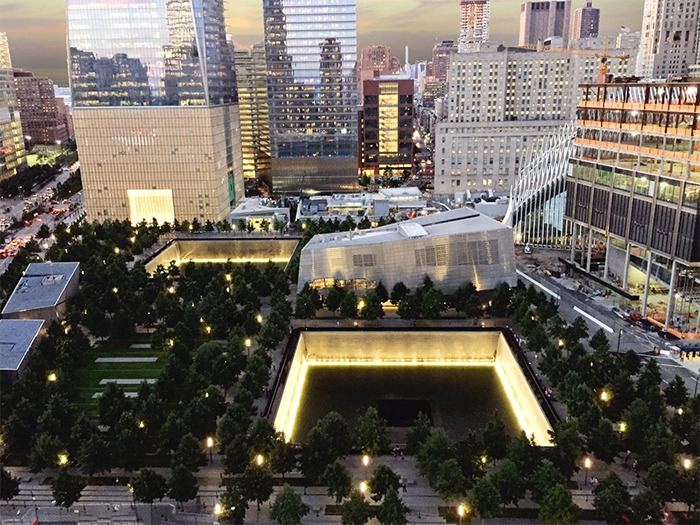
The 9/11 Memorial project is great example of applied research being carried out by lighting designers in the urban environment, proving it is possible to create darker spaces which are also safe, in metropoles such as New York. Lighting Design: Fisher Marantz Stone (Pic: www.exp1.com)
Granary Square, with the Grade II listed Granary Building, London, UK, forms part of a wider nighttime strategy developed by the UK-based Speirs Major in 2006, with discreet illumination that subtly highlights its historical importance, as well as a grid of trees. At night, when the square is unoccupied, the four rectangular water features are left static and dark, reflecting the architecture, to form a quiet, meditative, dark space (Figure 4). When Mark Major discussed with me an approach toward urban lighting masterplan [ULM] research, in connection with the King’s Cross project, he explained a very important design philosophy: “Unless [we] are committed to really spending time going around the site at night, taking photographs and recording lighting levels, talking to everyone involved and getting much deeper knowledge and doing a lot of research, we are in no position to make any recommendations, because [we] would be doing it from a position of ignorance.” [10] This clearly highlights why background research should be part of every project that a lighting designer decides to take on.

Granary Square, with the grade II listed Granary Building, London/UK. This project involves discreet illumination that subtly highlights its historical importance, as well as a grid of trees. Lighting Design: Speirs Major (Pic: © Argent/John Sturrock)
Biophilic office design
Secondly, there’s the fascinating and important emergence of biophilic design development. This has arisen to address the needs of those people who migrated from rural areas to cities during the 20th century. The abandonment of pastural and natural landscapes had physical and emotional consequences for these individuals, who now lived in man-made urban environments, often without greenery and trees. This urban growth continues to this day, with 68% of the current world population predicted to occupy cities by 2050 [11].
Due to the evolutionary disposition of humans, when people live in an urban habitat, they will still seek to restore their lost relationship with plants and the natural world by spending time in open green spaces outdoors, and by bringing plants indoors. As a consequence, at the turn of the 21st century, a noticeable global movement developed in the application of biophilic design principles in the projects of numerous, internationally recognised architectural practices. Clients and architects now expect their projects to incorporate theses new elements. Interestingly, when lighting manufacturers or plant specialists are consulted about how to illuminate ornamental plants in real life interior projects with LEDs, a lack of knowledge is apparent, as there are no worldwide established standards and recommendations regarding how to correctly illuminate indoor decorative vegetation. What’s more, if there is no daylight available for built environments, many plants do not survive so they need to be constantly replaced due to insufficiently designed and poorly specified artificial lighting.
When working on the Zurich Innovation Center Givaden, Julia Hartmann and her team from Lightsphere in Switzerland, designed special illumination for 12-metre green columns of ornamental plants in the new laboratory buildings that surround the atrium, which serves as a common space for encounters and exchanges.
It was vital that the plants thrive indoors, and a special luminaire was created using a biophilic approach to provide the right light spectrum (Figure 5). In order to understand the lighting that’s best for plants, numerous lighting mock-up scenarios were set up with various light sources, and the results were recorded via photographic documentation. Lighting research was also conducted, and the experiment was shared in an open access publication [12]. This project received an IALD Award of Merit in 2020, an IES Illumination Award of Merit in 2020, the Deutscher Lichtdesign Preis in 2020, a Lighting Design Award in 2020, and it was also a LIT Award Winner in 2019.
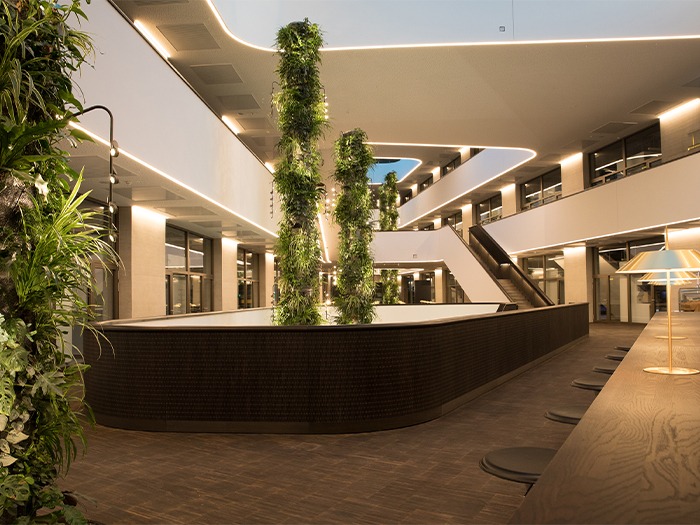
The Zurich Innovation Center Givaudan, Kemptthal/CH project provided a suitable light spectrum to allow indoors ornamental plants to thrive inside buildings. This is an example of pioneering biophilic office design. Lighting Design: Lightsphere. (Pic: © Filipa Peixeiro)
User oriented daylight integrated lighting (DIL)
Thirdly, we should apply user-oriented daylight integrated lighting (DIL) for interior illumination, which combines daylight and artificial lighting in indoor spaces to produce visual and biological benefits for humans. Sometimes the terms “circadian lighting” or “human centric lighting” (HCL) [13] are used interchangeably for interior illumination, yet artificial lighting cannot replace the unique qualities and characteristics of natural daylight. Additionally, it’s crucial to acknowledge that removing natural light from this equation is inappropriate because humans as a species have evolved under natural light.
As rightly indicated by Prof. Kevin Houser, in his lecture during Light Symposium Wismar 2020/21, “Human Centric Lighting: Myth, Magic, or Metaphor” the term HCL is clearly used for marketing purposes [14]. Researcher and Educator Asst. Prof. Ellen Kathrine Hansen and her team from Aalborg University, Copenhagen (AAU), use the term “double dynamic lighting” (DDL) to describe a concept for office spaces that combines natural daylight with artificial lighting in the space [15].
Light, be it natural or artificial, has a profound impact on our biology and the environment, so we need metrics that provide information relevant to this to enhance the existing practice of lighting design. The crucial challenge facing lighting professionals today regarding designing lighting schemes, is to provide LED lighting that is both visually and biologically safe to general health [16]. This is difficult as there’s still a wide lack of knowledge about the impact of LED technology, coupled with an absence of lighting products with clearly labelled characteristics such as SPD and flicker [17].
The American Society of Interior Designers Headquarters (ASIDH), completed in 2016, is one of the first pioneering projects that showcases both daylighting and the artificial lighting of interior spaces that’s centred on humans, their health and wellbeing. Lighting consultants Benya Burnett used existing research knowledge on light and lighting, and translated it into their unique design. For this project, the luminaire specification was completed in late 2015, when LEDs were still costly, therefore, designers specified and selected high output fluorescent lamps with 5000K uplight, and 3000K downlight components, integrated with the office luminaires. As for the luminaire CCT, the designers specified and selected lamps based on their SPD and the specified work or function of the occupants in that space.
Pre and post occupancy evaluations were conducted. The ASIDH staff wore sensing monitors that measured speech and body movements when people interacted with each other. This study provided data on how their interactions changed as a result of the new office design. The new design had numerous benefits including the following - “collaborative work increased by 9%, there was improved physical and mental health of employees, their productivity increased by 16%, and there was also an increase of 25% in sleep efficacy” [18].
A new concept of integrated circadian zeitgebers for the central work area was introduced, with controls that are aligned with a mechanical set for a gradual 14-minute shift in both light and ambient temperature, beginning at astronomical twilight and astronomical dawn (18° from horizon line). This was to initiate the cortisol awakening response (CAR) for those workers who were at their desks two hours before dawn and also for those working late. As well as applying a 14-minute period to align with the average solar movement above the building’s geographical location, the following factors were also considered: the time zone, latitude, compass direction of the window wall, height and shadow of adjacent buildings and the leading edge of location, the time zone, as well as the proximity to ocean and yearly average cloud cover. This was calculated manually, and the combined information was included in an in-depth survey. One on one interviews were also conducted with each occupant of the space in order to establish control sequences and light source specification.
After completion, this was the first project in the world to be certified platinum by both the U.S. Green Building Council, Leadership in Energy and Environmental Design (USGBC LEED) and the WELL V1 building standard. It has received an IES - San Francisco chapter Award for Excellence and an IES - International award of Excellence in Energy and Environmental Lighting Design.
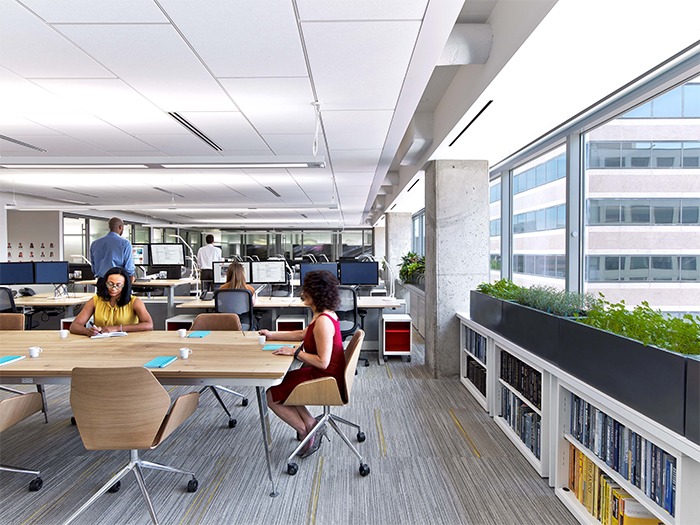
The American Society of Interior Designers Headquarters (ASIDH) is a pioneering example of user oriented daylight integrated lighting (DIL). Lighting Design: Benya Burnett (Pic: © ASIDH)
Key Takeaways
1.There is a great deal more to learn
It is important to understand that much more science and research is needed to further broaden our understanding of the impact of light upon living organisms. Additionally, we are facing an unprecedented shift in the lighting profession from a vision/perception-oriented lighting approach, to one that is orientated towards biology. It’s imperative that scientists and researchers provide new lighting metrics that can be easily understood and applied by the average lighting professional. There is already an international lighting standard which lighting professionals should become familiar with and apply [19].
2. Skills require an upgrade
It’s essential to upgrade our skills as lighting professionals. More than ever before, we need to become educated in order to interpret the circadian relevance of light and its biological stimulus for health and well-being.
3. New lighting equipment is needed
We need to start using spectroradiometers to measure SPDs to assess and specify lighting in individual environments, as CCT is an inadequate metric for LED lighting technology, especially when we look at lighting from a biological perspective.
4. The physics of light must be understood and respected
We need to look at light and its impact on humans, flora and fauna, in a way that takes various lighting characteristics into account, such as the percentage of energy contained within visible light (this means the percentage of short wavelengths and long wavelengths), as well as flicker.
5. New design rules apply
If we want to provide safer illumination that supports health and wellbeing, we need to approach projects differently to how they have been approached before. It’s essential to become knowledgeable about existing research and metrics in order to engage in conversations about responsible lighting with clients, colleagues, scientists and the lighting industry. This will involve additional time, effort and study. In my view, the only way to establish lighting design as a recognised profession is to ensure that a transdisciplinary design-led research approach is established, in order to generate strategies that support both the health and life quality of humans and wildlife.
To conclude, perhaps the words of American lighting designer Paul Gregory can guide us in the 21st century: “We consider every project an opportunity for greatness. We feel we are being given a canvas and a team of collaborators and that the only restriction is our creativity. We approach every project as a new beginning” [20].
So, let us start a new beginning today, by applying the above in our daily practice!
References
[1] Fundamental research. Available online: https://bit.ly/34gXGMN (accessed on 19 May 2021).
[2] Applied research. Available online: https://bit.ly/34jiwej (accessed on 19 May 2021).
[3] Pérez Vega, C.; Zielinska-Dabkowska, K.M.; Hölker, F. Urban Lighting Research Transdisciplinary Framework—A Collaborative Process with Lighting Professionals. Int. J. Environ. Res. Public Health 2021, 18, 624. https://doi.org/10.3390/ijerph18020624
[4] Falchi, F.; Cinzano, P.; Duriscoe, D.; Kyba, C.C.M.; Elvidge, C.D.; Baugh, K.; Portnov, B.A.; Rybnikova, N.A.; Furgoni, R. The new world atlas of artificial night sky brightness. Sci. Adv. 2016, 2, e1600377 https://doi.org/10.1126/sciadv.1600377
[5] Longcore, T.; Rich, C. Ecological light pollution. Front. Ecol. Environ. 2004, 2, 191–198. Available online: https://bit.ly/34hceMe (accessed on 10 March 2020).
[6] Spivey, A. Light Pollution: Light at Night and Breast Cancer Risk Worldwide. Environ. Health Perspect. 2010, 118, A525. Available online: https://bit.ly/34TuxaG (accessed on 19 May 2021)
[7] Jägerbrand, A.K.; Bouroussis, C.A. Ecological Impact of Artificial Light at Night: Effective Strategies and Measures to Deal with Protected Species and Habitats. Sustainability 2021, 13, 5991. https://doi.org/10.3390/su13115991
[8] Zielinska-Dabkowska, K.M.; Xavia, K.; Bobkowska, K. Assessment of Citizens’ Actions against Light Pollution with Guidelines for Future Initiatives. Sustainability 2020, 12, 4997. https://doi.org/10.3390/su12124997
[9] Zielinska-Dabkowska, K.M. Knowing when to say no. Arredo & Citta, 2019, 2, pp. 64-73. https://bit.ly/3wziZFh
[10] Zielinska-Dabkowska, K.M. Urban Lighting Masterplan—Definitions, Methodologies and Collaboration. In Urban Lighting for People: Evidence - Based Lighting Design for the Built Environment, 1st ed.; Davoudian, N., Ed.; RIBA Publishing: London, UK, 2019; pp. 18–41. ISBN 9781859468210 https://bit.ly/2SskhmL
[11] 68% of the world population projected to live in urban areas by 2050, says UN. Available online: https://www.un.org/development/desa/en/news/population/2018-revision-of-world-urbanization-prospects.html (accessed on 19 May 2021).
[12] Zielinska-Dabkowska, K.M.; Hartmann, J.; Sigillo, C. LED Light Sources and Their Complex Set-Up for Visually and Biologically Effective Illumination for Ornamental Indoor Plants. Sustainability 2019, 11, 2642. https://doi.org/10.3390/su11092642
[13] Zielinska-Dabkowska K.M. Human Centric Lighting. The New X Factor? arc magazine 2019,108, pp.081-086. ISSN 1753-587 http://bit.ly/3bgHhu5
[14] Houser, K. Human Centric Lighting: Myth, Magic, or Metaphor. Available online: https://bit.ly/34kvg4k (accessed on 19 May 2021).
[15] Hansen, E.K.; Bjørner, T.; Xylakis, E.; Pajuste M. An experiment of double dynamic lighting in an office responding to sky and daylight: Perceived effects on comfort, atmosphere and work engagement. Indoor and Built Environment 2021. http://doi.org/10.1177/1420326X21991198
[16] Zielinska-Dabkowska K.M. Home Sweet Home. Connecting the dots for healthy evening residential illumination. arc magazine 2019, 111, pp.055-060. ISSN 1753-5875 http://bit.ly/30TqCss
[17] Zielinska-Dabkowska K.M., Kelly Waskett R. Three Principles for Healthy Living with Light and Lighting. arc magazine 2021, 121, pp. 116-117. ISSN 1753-5875 https://bit.ly/3yJ3bSu
[18] Impact of Design Series, Vol. 1. Available online: https://www.asid.org/impact-of-design/asid (accessed on 19 May 2021).
[19] Commission International de L’Éclairage (CIE). CIE System for Metrology of Optical Radiation for ipRGC Influenced Responses to Light; Standard CIE S 026/E:2018; Commission International de L’Éclairage (CIE): Vienna, Austria, 2018. Available online: https://cie.co.at/publications/cie-system-metrology-optical-radiation-iprgc-influenced-responses-light-0 (accessed on 19 May 2021).
[20] Gregory P. The Lighting Designer’s new role and responsibility. In Proceedings of the 1st Global Lighting Design Convention PLDC, London, UK, 24–27 October 2007; VIA Verlag: Guetersloh, Germany, 2007; pp. 45–46.
Lichtvision Design and weisspunkt und purpur join forces
(Germany) – Berlin-based lighting design office weisspunkt und purpur (wpp), has merged with Lichtvision Design, with wpp Founder Christian Spork joining Lichtvision as Design Director.
The new partnership is intended to meet the growing demands of the lighting design industry, offering clients a wider range of services, covering both technological innovation and creative exploration.
With a background in industrial design and mediatecture, Spork describes himself as a multimedia set designer for events and brands, as well as a designer for the staging of experience spaces and classic architecture. For more than 25 years, he has been realising projects around the world, from diverse events and stage shows, through retail concepts such as flagship stores and brand spaces, to exhibitions and museums.
“For me, working with Lichtvision is a kind of quintessence of my professional life and creates a space in which I can concentrate fully on my strengths and have more creative freedom to implement projects,” Spork said of the merger.
Karsten Ehling, Lichtvision Managing Director, added: “We have known Christian for almost two years and when we look at his work, we are always enthusiastic about the passion and patience, narrativity and precision with which he implements projects.
“In our conversations, we discovered that we share the same values and that we can enrich each other’s portfolio. It was therefore an obvious step to pursue our visions together. His expressiveness in terms of content and his ability to tell stories with light enriches us and our partners.”
Spork and wpp have been supporting the Lichtvision team since August 2020. For customers of both offices, nothing will change in the tried and tested working method – wpp’s clients will now benefit from the large team and Lichtvision’s experience in managing complex, large-scale projects, as well as from in-depth knowledge on daylight solutions and media façades.
www.lichtvision.com
www.weisspunktundpurpur.de
“Passion for lighting will be our strength moving forward” says new ILP President
(UK) – In her President’s Address, new Institution of Lighting Professionals (ILP) President Fiona Horgan said that passion for lighting is what “keeps us all connected and will be our strength moving forwards”.
Horgan became the Institution’s 90th President and the second woman to ever hold the role at the ILP AGM, held yesterday.
Quoting Martin Luther King Jnr, she said: “Our very survival depends on our ability to stay awake, to adjust to new ideas, to remain vigilant and to face the challenge of change.”
Horgan added: “I am set to take on this challenge to see the ILP at the other side for the members as we strive to achieve an all-inclusive professional community. I ask the wider membership to be patient and allow time for our recovery but also continue to voice your support for the good work being done by our staff and volunteers.”
Aside from volunteering for the ILP, Horgan is Senior Design Engineer Manager at Doncaster Council in South Yorkshire.
Ros Jones, Mayor of Doncaster, said: “It’s a great honour for Fiona to be announced as the 90th President of the ILP, and only the second female recipient. It’s tremendous recognition from her peers.”
Damian Allen, Chief Executive of Doncaster Council, added: “Fiona has shown herself to be diligent and collaborative, which will be a big asset to the ILP in her role as President. We would all like to congratulate Fiona on her appointment and wish her every success in this new role.”
The AGM also saw confirmation of Rebecca Hatch IEng MILP as Senior Vice President and Perry Hazell as Junior Vice President.
Registration opens for LightFair 2021
(USA) – Registration has officially opened for the LightFair 2021 conference and trade show, taking place at the Jacob K. Javits Center in New York from 27-29 October.
The 31st staging of the event will feature more than 300 exhibitors, presenting their latest advancements in lighting and technology in person.
“We are excited to open registration for the first in-person lighting event to be held in more than two years,” said Dan Darby, LightFair show director. “The marketplace is eager to see the products developed since our 2019 staging and to greet their friends and colleagues again in person.”
As one of the first major trade shows to take place following the Covid-19 pandemic, LightFair organisers are putting extra precautions in place to ensure the safety of attendees. As such, it will feature adaptions for safer product exploration and education, as outlined in its Safer Floor. Safer Show guidelines. It will also follow the most updated recommendations and guidelines from the CDC and New York State.
Measures will include wider aisles with one-way traffic. Digital tools will also be a key element of the show, with appointment setting available via LightFair’s mobile app, and the use of electronic lead retrieval/digital information sharing strongly encouraged. All attendees will also be asked a health screening questionnaire and have their temperature checked prior to entry, while the wearing of masks will also be required.
ewo FA COR-TEN
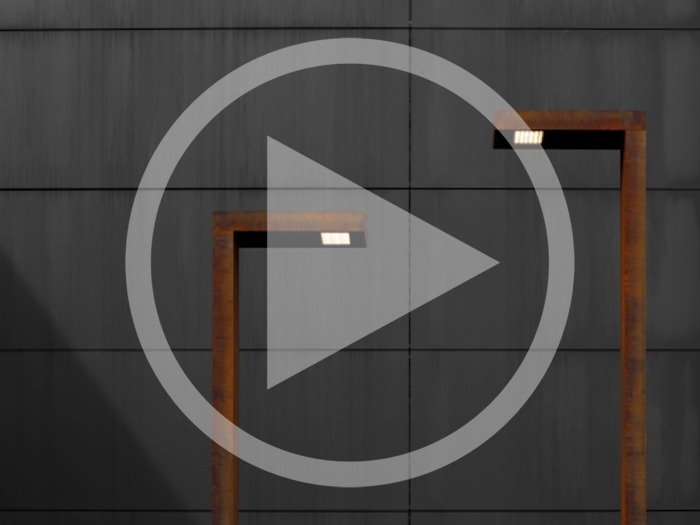
In this video, ewo outlines the key differences between its industry-leading A–Series and T–Series optics, as featured within its robust and striking FA COR-TEN luminaire. In addition to a brief demo of easy-to-use smart lighting features, this video shows how ewo can help you empower wellbeing outdoors.
Video: Domenico Palma
Women In Lighting Awards 2021
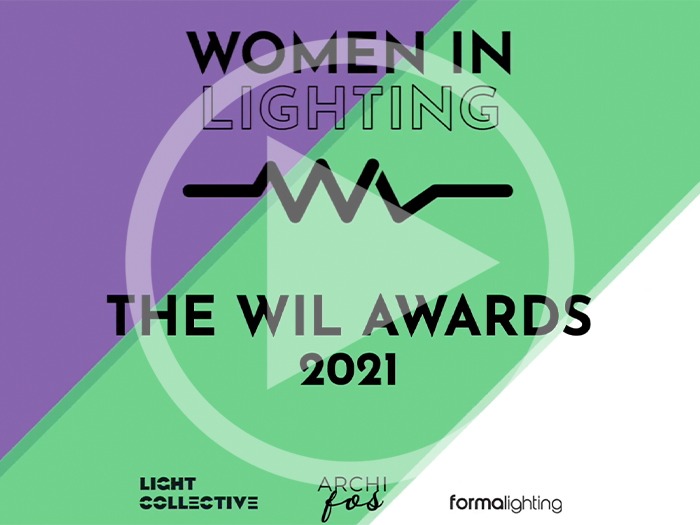
The Women in Lighting Awards were created to seek out and celebrate women’s achievements and the achievements of those who support them within the field of architectural lighting design.
The winners of the inaugural WiL Awards were revealed in an online presentation, held on 10 June.
Video courtesy of Light Collective.
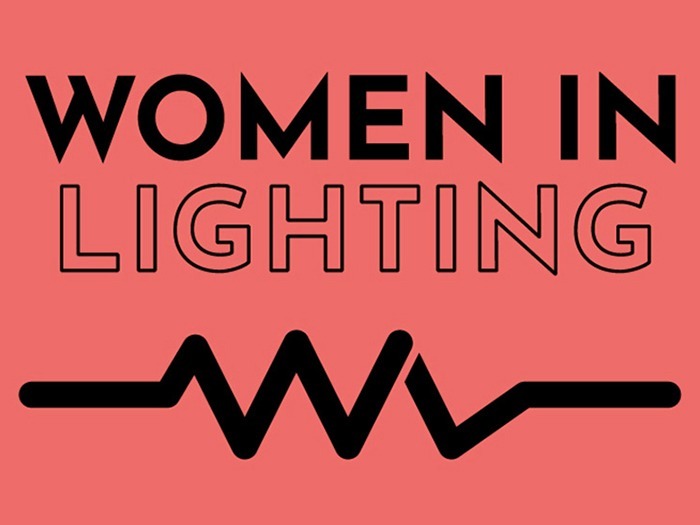
Women in Lighting Award winners announced
(Online) – In an online ceremony held on 10 June, the winners of the inaugural Women in Lighting Awards were announced.
Established to seek out and celebrate women’s achievements, and the achievements of those who support them, the WIL Awards was open to nominations for accomplishments large or small, for people that did something special in 2020, and was broken down into three separate categories – Achievement, Initiatives and Supporters.
Entries opened on 8 March, to coincide with International Women’s Day, and throughout the entry a process, a total of 180 nominations were made, resulting in 141 nominees from across 36 countries.
Each category had a separate judging panel, comprised of Women in Lighting Ambassadors, and two winners were selected from each category.
The Initiative category looked to highlight new ideas and initiatives that sit alongside the lighting industry, celebrate ideas that push the lighting profession forward, or use light to help the wider community. The two winning initiatives were Light for Lebanon and Light Reach, led by Manal Kahale and Nathalie Rozot respectively – both of which are intertwined with each other.
Shortly after the devastating explosion in Beirut in August 2020, Lebanese lighting designer Manal Kahale partnered with the global charitable initiative Light Reach to launch “Light for Lebanon.” Using Light Reach’s three-tiered solar lighting model, the programme supports residents’ everyday lighting needs, whether practical, social or cultural, both indoors (with portable solar lanterns) and outdoors (with solar security lights and solar streetlights for building entrances, streets, historic building façades, playgrounds and public spaces).
To date, Light for Lebanon has raised US$75K and already afforded the purchase of almost 1,500 solar lights. Kahale’s ground team has provided lighting to the Beirut Fire Brigade and distributed solar lanterns to residents plunged in darkness and to address immediate safety and security issues.
Light Reach was set up by Rozot, and is a solar lighting initiative by lighting think-tank PhoScope, designed to leapfrog over utility grids to light work and play, and to boost the wellbeing and economic growth of underserved communities worldwide. As well as supporting Lebanon, they have also worked on projects in Puerto Rico. Light Reach is a WiL partner, and any profit from the sale of WiL T-shirts is forwarded on to help fund its projects.
The Supporter category was intended to shine a spotlight on those who have helped us in our lives – people who enable us to keep moving forward and have mentored us or supported us in some way. The winners of this category were Chiara Carucci, Italian lighting designer based in Sweden; and Lisa Reed, a lighting designer in the USA.
Founder of the IALD Nordic chapter and, together with Giacomo Rossi, founder of the Facebook group "Italian Lighting Design promotion group", which is aimed at spreading the culture of light and promoting lighting design in Italy, Carucci also supports and publishes WiL events on social networks and collaborates with the WiL ambassador in Italy in the organisation of various initiatives.
Lisa Reed has an extensive professional resume of awards and is known for her altruistic character and dedication to helping others. She founded Ladies of Lighting in St. Louis, helped expand WILD across the USA and is a passionate advocate for diversity in lighting. She received the 2014 IES Presidential Award for her work with Emerging Professionals and in 2020, she was named as one of the top 20 women in construction in St Louis. She also co-authored the survey Why Women Leave Design and how to Keep Them and presented the results at IALD Enlighten 2018.
The final category, Achievement, honoured the achievements of two icons in the lighting design industry who have been a massive inspiration to female lighting designers throughout their careers – Barbara Horton and Motoko Ishii.
Barbara Horton retired a few months ago having spent more than 40 years as a lighting designer, rising to CEO of HLB Lighting, and enabling it to become the largest female-owned company in the USA during her tenure. She has mentored many young professionals, is a Past President of IALD and one of the founders of the Women In Lighting Design (WILD) movement.
When WiL was established, she said: “Women in lighting design have somehow broken the glass ceiling in many parts of the world by creating their own destiny, starting their own firms and being recognised for their achievements. With more awareness, communication and mentoring we can continue to educate and support those who still struggle and ensure future generations will continue to succeed in lighting design and other parts of the industry.”
Motoko Ishii was accorded the highest accolade in Tokyo on 1 October 2020, when she was named as a Tokyo Honorary Citizen and commended by the Tokyo Metropolitan Government as someone who has contributed to the rise of Japanese social culture. She has had a 52-year career in lighting and has achievements too numerous to mention.
Ishii also supplied a quote for the WiL website when it launched: “I am very glad to say to all the people who are engaging in lighting business that the highest position of Japanese mythology is a Goddess called Amaterasu. She is the Goddess of Light and her power is falling all over the world. Please read Japanese mythology and recognise women’s power.”
The full awards presentation is available to view online here.

LIA issues response to UK Government’s proposed lighting regulations
(UK) – The UK Government this week issued a press release outlining the impact of upcoming new lighting regulations that, it claims, would see the sale of halogen light sources banned from September, with fluorescent lights to follow.
The ban is part of a move to boost energy savings, and it is estimated that it will cut 1.26 million tonnes of carbon emissions a year, the release stated.
Under EU-wide rules, the UK began phasing out the sale of higher-energy halogen lamps in 2018, and it is thought that the plan will help continue the shift towards lower-energy LED sources, which currently account for around two-thirds of lights now sold. Officials said that it is expected that LEDs will account for 85% of all sources sold in the UK by 2030.
However, the news has been met with confusion among suppliers and consumers alike, with the Lighting Industry Association (LIA) claiming that the official release contains “a number of errors”.
In an attempt to clarify the situation, the LIA released the following statement:
“The UK legislation, due for publication in the summer, mirrors that also applying in the EU and relates to the “placing on the market” of products, this allows products in stock at manufacturers, retailers, etc. to continue to be sold until stocks are exhausted. It is not an instant sales ban. There is a legal definition of “placing on the market” which may mean that certain goods in suppliers’ warehouses are already considered as such.
“The proposed UK legislation, which applies from 1 September, is expected to have a one-month transition allowance.
The following lamps cannot be placed on the market after 1st October 2021:
- Self-ballasted Compact Fluorescent retrofit lamps (caps B22, E27 etc)
- Linear Halogen R7s lamps over 2,700 lumens
- 12V Halogen reflectors lamps (MR11/GU4, MR16/GU5.3 etc)
- Lower performing LED lamps
The following lamps cannot be placed on the market after 1st September 2023:
- Linear fluorescent lamps T8 2 foot, 4 foot, 5 foot
- Mains voltage Halogen capsules with G9 cap
- 12V Halogen capsules with G4/GY6.35 cap
“Lighting fixtures/fittings (luminaires) with non-replaceable/fixed lamps are not banned but this type of design is being discouraged in the future with a technical justification being required for these designs.”
The LIA has highlighted the following errors within the Government’s official release, which it believes is leading to the confusion:
Halogen light bulbs to be banned from this September – with fluorescent light bulbs to follow suit
“This suggests that all halogen lamps are banned from this September – this is not the case, some will continue until 2023. Those lamps that are banned from 1 September may still be available for sale if they were first placed on the market before that date,” the LIA state.
Legislation being brought forward this month will also include the removal of fluorescent lights from shelves from September 2023.
“This is also not the case, only some lengths of T8 fluorescent lamps will be banned from September 2023, other types of fluorescent lamps will still be available.”
The new legislation would mean retailers will no longer be able to sell the majority of halogen bulbs for general household use in the UK from 1 September.
The LIA responded: “This is incorrect, retailers will be able to sell through existing stocks and any products placed on the market before 1 September may also be sold. Some types will continue to be allowed after 1 September (as above).”
The plans also include a ban from September on the sale of lighting fixtures with fixed bulbs that can’t be replaced – meaning the fixtures have to be thrown away.
“This is misleading – new measures have been introduced which encourage the design of light fittings which can be repaired, or the light source and control gear replaced. There is not a blanket ban on lighting products where these components cannot be replaced if the manufacturer provides a technical justification for this case such as safety, water ingress or other reason.”
The LIA has communicated these errors to the Government department responsible for the press release.
LED Linear: The Ultima Family

The Ultima family focuses on efficient design that uses as little material as possible. LED Linear addressed the core issue designers and architects face when selecting a luminaire: smaller products mean less light, while robust products compromise on resources and design but are more efficient. The company's drive was to combine the best of both worlds and develop the smallest and most efficient luminaire for the market.
With a high degree of variability and minimalist compactness, the Ultima family allows new design freedom in architectural lighting. By using innovative nano-optics, the luminaire size could be reduced to a cross-section of 10x13mm while improving lighting effects. From spotlight to batwing, a total of seven precise light distributions with maximum colour consistency are available. The glare control (up to UGR < 13) means that the light source remains hidden.
ULTIMA-S (Stand-alone)
Ideal for integration on grid ceilings or as surface mounting, but also for furniture integration, showcase or display lighting.
ULTIMA-T (Track)
The luminaire system is ideal for offices, galleries, museums and generally for rooms where different types of lighting are required within specific areas. The pendant track variant will complement the ULTIMA-T series in autumn.
ULTIMA-P (Pendant)
ULTIMA-P is ideal above counters in entrance areas, hotel receptions, bars, but also above work desks as well as tables in meeting rooms.
Studiotech enter creative partnership with Venture Arts
(UK) – Specialist architectural lighting company Studiotech has entered into a creative partnership with Manchester-based arts charity Venture Arts.
The award-winning charity, who supports people with learning disabilities to reach their full potential through visual arts and culture, will work with Studiotech on a series of projects, together finding new and dynamic ways to bring artwork to life and present illuminated work in unusual public settings.
The partnership begins with the installation of a giant cube light sculpture for Manchester Flower Show – a city-wide trail of floral displays, green installations, outdoor dining and entertainment, which began on 29 May.
Venture Arts consulted on the aesthetics and design of the sculpture, created by Studiotech, alongside partners Sutton Creative, which incorporates snippets of writing cast in thought-provoking shadows on the floor.
Positioned in a prime location in central Manchester, the installation features an additional cube with fully programmed pixel boards that can be controlled by members of the public. This allows for bystanders to change the colour of the artwork via hashtags on social media.
Venture Arts Director Amanda Sutton said: “We are thrilled to be partnering with Studiotech and to be working together on the first of a series of highly visible and dynamic projects, which will enable our artists to marry their artistic vision with technology and to see a unique project brought to life in the centre of Manchester as a vibrant and innovative piece of public art for all to enjoy.”
Natalie Critchard, Studiotech Marketing Manager, added: “When we discovered that Manchester was hosting a flower show to ‘bring the city back’, reunite communities and build confidence, we knew that it would be the perfect platform to present our new partnerships with Venture Arts and Sutton Creative. For Studiotech, the sculpture represents collaboration, hope, diversity and awareness. We are delighted to have this opportunity to showcase our work and the incredible art from Venture Arts to our local community.”
Studiotech Creative Lead Karen Owens continued: “When we first met with the Venture Arts family, there was an immediate connection. We knew that together we could create magic and evoke wonder in others. Through the mediums of art and light we will be bold and raise awareness of the importance of diversity and inclusion. Together we will make our world a brighter place.”
www.studiotech.co.uk
www.venturearts.org

